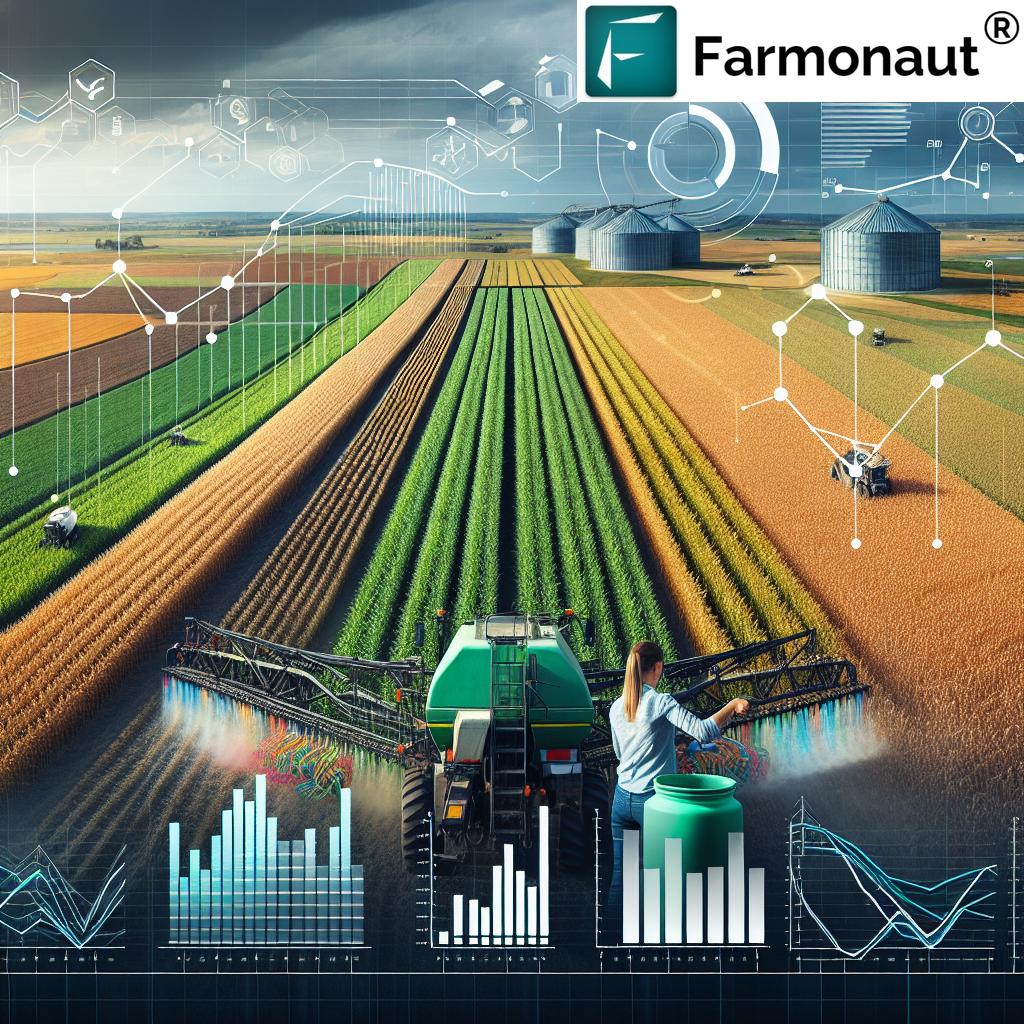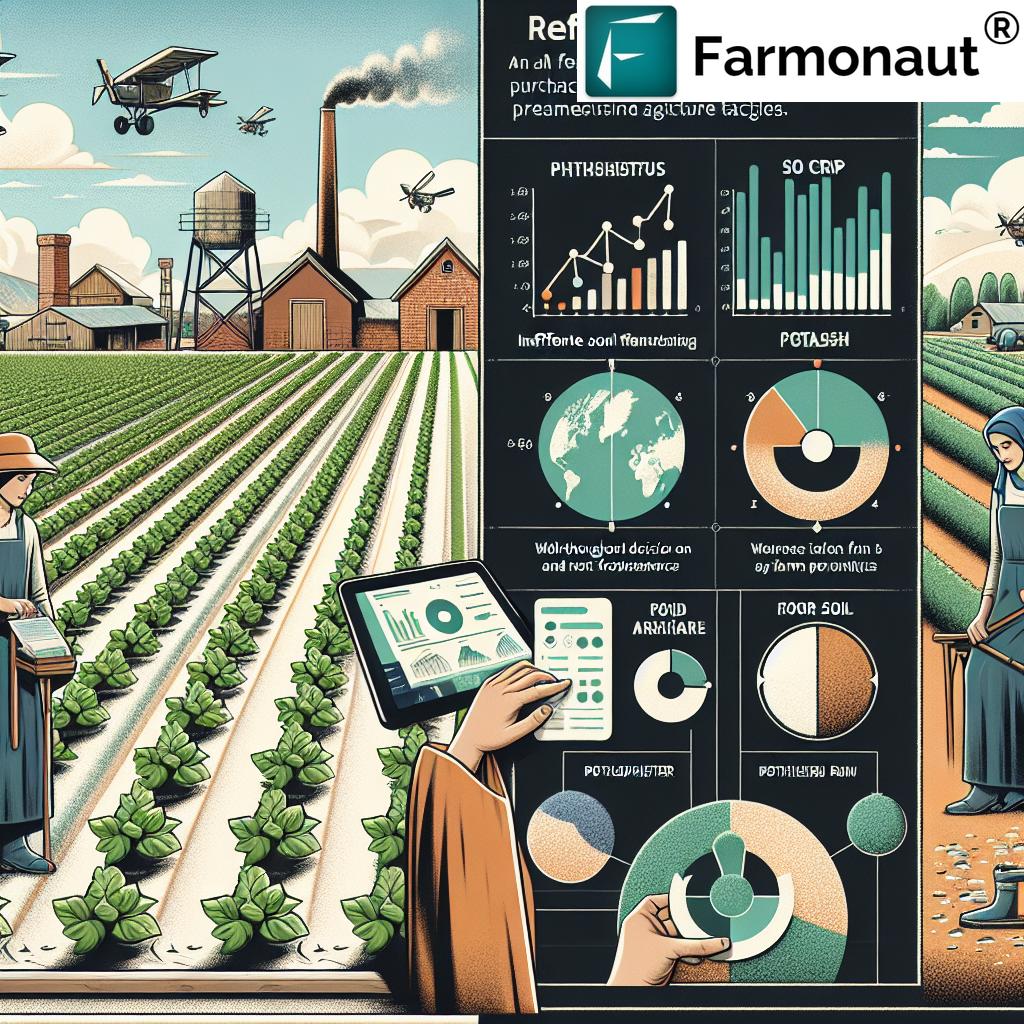Global Fertiliser Market Trends: Expert Analysis and Strategic Insights for Farmers
“Global fertilizer prices have experienced up to 30% fluctuations in recent years due to supply-demand factors and geopolitical issues.”
Welcome to Farmonaut’s comprehensive analysis of the global fertiliser market trends. As leaders in agricultural technology, we at Farmonaut are committed to providing farmers and agribusinesses with crucial insights to navigate the complex landscape of agricultural inputs. In this report, we delve deep into the latest trends shaping the fertiliser industry, offering strategic insights to help you make informed decisions for your farming operations.
The Dynamic Landscape of Global Fertiliser Markets
The fertiliser market is a critical component of the agricultural sector, playing a pivotal role in ensuring global food security. As we analyze the current state of affairs, it’s essential to understand the intricate dynamics influencing fertiliser prices, supply chains, and farming practices worldwide.
- Volatile price fluctuations
- Shifting supply-demand equilibrium
- Geopolitical influences on production and distribution
- Environmental regulations impacting fertiliser use
These factors collectively contribute to a market environment that requires constant vigilance and adaptive strategies from farmers and agribusinesses alike.

Nitrogen Fertiliser Supply: A Global Perspective
Nitrogen fertilisers, essential for crop growth and development, have been subject to significant market pressures. Our analysis reveals several key trends:
- Production capacities in major exporting countries
- Impact of energy prices on nitrogen fertiliser costs
- Emerging technologies in nitrogen fixation
- Environmental policies affecting nitrogen use efficiency
The nitrogen fertiliser market remains highly sensitive to global energy markets, particularly natural gas prices. As a result, farmers must stay informed about energy trends to anticipate potential impacts on fertiliser costs.
Phosphate and Potash Market Dynamics
The phosphate and potash sectors of the fertiliser market have their unique characteristics and challenges:
- Concentrated production in specific geographic regions
- Long-term mining investments influencing supply
- Crop rotation practices affecting demand patterns
- Emerging markets driving global consumption
Understanding these dynamics is crucial for farmers looking to optimize their fertiliser purchasing strategies and crop nutrition programs.
Crop Fertilisation Strategies Amidst Price Fluctuations
In the face of volatile fertiliser prices, adopting smart fertilisation strategies is more important than ever. Consider the following approaches:
- Precision agriculture techniques for optimized application
- Soil testing and nutrient management planning
- Alternative nutrient sources and organic amendments
- Crop rotation and cover cropping for improved soil fertility
At Farmonaut, we provide cutting-edge satellite-based solutions to help farmers implement these strategies effectively. Our advanced farm management platform offers real-time insights into crop health and soil conditions, enabling precise and timely fertiliser applications.

Farm Input Cost Management: A Critical Skill
“Farmers can potentially reduce input costs by 15-20% through strategic timing of fertilizer purchases based on market trends.”
Effective management of farm input costs, particularly fertilisers, can significantly impact a farm’s profitability. Here are key strategies to consider:
- Monitoring global and regional fertiliser price trends
- Bulk purchasing and storage when prices are favorable
- Exploring cooperative buying arrangements
- Implementing variable rate technology for precise application
Farmonaut’s Android and iOS apps provide real-time market insights and crop monitoring tools to support these cost management strategies.
Global Fertiliser Prices: Trends and Projections
Understanding current price trends and future projections is essential for strategic planning in agriculture. Our analysis shows:
- Short-term price volatility due to supply chain disruptions
- Long-term trends influenced by population growth and dietary changes
- Regional price disparities and their impact on global trade
- Emerging markets and their influence on global demand
Farmers and agribusinesses must stay informed about these trends to make timely decisions on fertiliser purchases and application strategies.
Optimizing Fertiliser Purchases: Timing and Strategy
Strategic timing of fertiliser purchases can lead to significant cost savings. Consider the following factors:
- Seasonal price fluctuations and off-season purchasing opportunities
- Forward contracts and hedging strategies
- Monitoring global production and trade patterns
- Balancing storage costs with potential savings
Farmonaut’s API and developer documentation provide tools for integrating market data into your farm management systems, enabling data-driven purchasing decisions.
Navigating the Complex Landscape of Agricultural Inputs
The fertiliser market is just one aspect of the broader agricultural input sector. To succeed, farmers must consider:
- Integrated crop management approaches
- Balancing fertiliser use with other inputs like pesticides and seeds
- Adopting sustainable farming practices
- Staying informed about agricultural policies and subsidies
Farmonaut’s comprehensive farm management solutions help you navigate these complexities with ease.
The Impact of Global Events on Fertiliser Markets
Recent global events have had significant impacts on the fertiliser industry:
- COVID-19 pandemic disruptions to supply chains
- Geopolitical tensions affecting major producing countries
- Climate change impacts on agricultural productivity
- Shifts in international trade agreements
Understanding these macro-level factors is crucial for anticipating market shifts and adapting farm strategies accordingly.
Sustainable Fertilisation Practices: Balancing Productivity and Environmental Stewardship
As the agricultural sector faces increasing pressure to reduce its environmental footprint, sustainable fertilisation practices are becoming more critical:
- Precision agriculture for optimized nutrient application
- Use of slow-release and controlled-release fertilisers
- Integration of organic and inorganic nutrient sources
- Adoption of conservation tillage and other soil health practices
Farmonaut’s satellite-based crop monitoring tools support these sustainable practices by providing accurate, real-time data on crop health and soil conditions.
The Role of Technology in Modern Fertiliser Management
Technological advancements are revolutionizing fertiliser management:
- AI-driven predictive models for nutrient needs
- IoT sensors for real-time soil nutrient monitoring
- Drone and satellite imagery for precision application
- Blockchain for supply chain transparency and traceability
Farmonaut is at the forefront of these technological innovations, offering farmers advanced tools to optimize their fertiliser use and crop management strategies.
Global Fertiliser Market Trends Comparison
| Fertiliser Type | Current Market Price ($/tonne) | Year-over-Year Price Change (%) | Supply Status | Key Producing Countries | Major Demand Drivers | Future Outlook (Short-term) |
|---|---|---|---|---|---|---|
| Nitrogen | 350 | +15% | Balanced | China, Russia, USA | Cereal crops, industrial use | Stable with potential for slight increase |
| Phosphate | 420 | +8% | Slight Surplus | China, Morocco, USA | Fruits and vegetables, biofuel crops | Gradual price decline expected |
| Potash | 380 | -5% | Deficit | Canada, Russia, Belarus | Cash crops, palm oil plantations | Prices likely to rise due to supply constraints |
Conclusion: Navigating the Future of Fertiliser Markets
As we look to the future, the global fertiliser market will continue to be characterized by complexity and change. Farmers and agribusinesses that stay informed, adopt innovative technologies, and implement strategic approaches to fertiliser management will be best positioned to thrive in this dynamic environment.
At Farmonaut, we remain committed to empowering farmers with the tools and insights needed to navigate these challenges successfully. Our advanced satellite-based solutions, AI-driven advisory systems, and comprehensive farm management platforms are designed to support you every step of the way.
We encourage you to explore our range of services and discover how Farmonaut can help you optimize your fertiliser strategies and improve your farm’s productivity and profitability.
Farmonaut Subscriptions
Frequently Asked Questions
Q: How often should I reassess my fertiliser strategy?
A: We recommend reviewing your fertiliser strategy at least annually, ideally before the start of each growing season. However, given the volatility in fertiliser markets, more frequent assessments may be beneficial, especially if there are significant changes in global market conditions or local agricultural policies.
Q: Can technology really help me save on fertiliser costs?
A: Absolutely. Technologies like Farmonaut’s satellite-based crop monitoring can provide precise insights into your crop’s nutrient needs, helping you apply fertilisers more efficiently. This targeted approach can lead to significant cost savings while maintaining or even improving crop yields.
Q: How do global events impact local fertiliser prices?
A: Global events can have significant ripple effects on local fertiliser prices. For example, disruptions in major producing countries can lead to supply shortages and price spikes worldwide. Similarly, changes in energy prices can affect the cost of nitrogen fertiliser production. Staying informed about these global trends is crucial for understanding and anticipating local price movements.
Q: What are some sustainable alternatives to traditional fertilisers?
A: Several sustainable alternatives are gaining popularity, including:
- Organic fertilisers derived from plant or animal sources
- Biofertilisers containing beneficial microorganisms
- Green manures and cover crops for natural soil enrichment
- Precision farming techniques that optimize nutrient use efficiency
Farmonaut’s technology can help you implement and monitor the effectiveness of these alternatives.
Q: How can I protect my farm from fertiliser price volatility?
A: Several strategies can help mitigate the impact of price volatility:
- Diversifying your fertiliser sources
- Considering long-term contracts or futures markets
- Implementing precision agriculture to optimize fertiliser use
- Exploring cooperative purchasing arrangements with other farmers
- Regularly monitoring market trends using tools like Farmonaut’s platform






